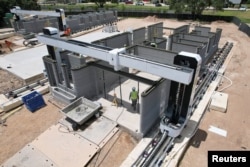
This article was originally published on VOA News - America. You can read the original article HERE
As with any desktop 3D printer, the Vulcan printer pipes layer by layer to build an object – except this printer is more than 45 feet (13.7 m) wide, weighs 4.75 tons and prints residential homes.
This summer, the robotic printer from ICON is finishing the last few of 100 3D-printed houses in Wolf Ranch, a community in Georgetown, Texas, about 30 miles from Austin.
ICON began printing the walls of what it says is the world's largest 3D-printed community in November 2022. Compared to traditional construction, the company says that 3D printing homes is faster, less expensive, requires fewer workers, and minimizes construction material waste.
"It brings a lot of efficiency to the trade market," said ICON senior project manager Conner Jenkins. "So, where there were maybe five different crews coming in to build a wall system, we now have one crew and one robot."
After concrete powder, water, sand and other additives are mixed together and pumped into the printer, a nozzle squeezes out the concrete mixture like toothpaste onto a brush, building up layer by layer along a pre-programmed path that creates corduroy-effect walls.
The single-story three- to four-bedroom homes take about three weeks to finish printing, with the foundation and metal roofs installed traditionally.
Jenkins said the concrete walls are designed to be resistant to water, mold, termites and extreme weather.
Lawrence Nourzad, a 32-year-old business development director, and his girlfriend Angela Hontas, a 29-year-old creative strategist, purchased a Wolf Ranch home earlier this summer.
"It feels like a fortress," Nourzad said, adding that he was confident it would be resilient to most tornados.
The walls also provide strong insulation from the Texas heat, the couple said, keeping the interior temperature cool even when the air conditioner wasn't on full blast.
There was one other thing the 3D-printed walls seemed to protect against, however: a solid wireless internet connection.
"Obviously these are really strong, thick walls. And that's what provides a lot of value for us as homeowners and keeps this thing really well-insulated in a Texas summer, but signal doesn't transfer through these walls very well," Nourzad said.
To alleviate this issue, an ICON spokeswoman said most Wolf Ranch homeowners use mesh internet routers, which broadcast a signal from multiple units placed throughout a home, versus a traditional router which sends a signal from one device.
The 3D-printed homes at Wolf Ranch, called the "Genesis Collection" by developers, range in price from around $450,000 to close to $600,000. Developers said a little more than one quarter of the 100 homes have been sold.
ICON, which 3D-printed its first home in Austin in 2018, hopes to one day take its technology to the Moon. NASA, as part of its Artemis Moon exploration program, has contracted ICON to develop a construction system capable of building landing pads, shelters, and other structures on the lunar surface.
This article was originally published by VOA News - America. We only curate news from sources that align with the core values of our intended conservative audience. If you like the news you read here we encourage you to utilize the original sources for even more great news and opinions you can trust!













Comments